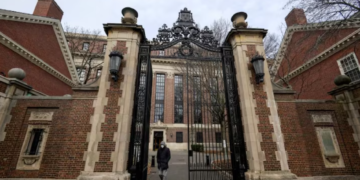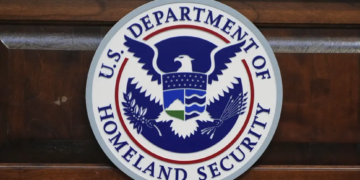April 11, 2025 Story by: Editor
Donald Trump is aiming to reshape the historic U.S. Commission on Civil Rights by steering its focus toward his priorities.
This would mark a major departure from the commission’s founding purpose. Created nearly seven decades ago, the bipartisan commission was tasked with investigating discrimination and influencing the nation’s civil rights legislation. Its efforts were pivotal in shaping landmark laws like the Civil Rights Act, the Voting Rights Act, and the Americans with Disabilities Act.
To shift the balance of the eight-member commission, Trump is trying to unseat Democratic chair Rochelle Garza and replace her with conservative Republican Peter Kirsanow, an employment lawyer and frequent conservative commentator. Kirsanow has opposed affirmative action and diversity, equity, and inclusion (DEI) initiatives, and has vocally supported a range of right-wing cultural causes.
In March, officials at the commission received a short email from the White House stating that Garza was being “de-designated” as chair and Kirsanow was being elevated.
Garza, however, is resisting the move, arguing that it’s not legally valid. “This is a way of trying to circumvent our authorizing statute, it’s very clear,” she said. “They’ve been relentlessly dismantling every single civil rights agency in the federal government, and this could be the last one standing.” She added, “I am prepared to challenge any attempt to illegally remove me as chairwoman.”
When asked by POLITICO who currently leads the commission, the agency gave an ambiguous response: “In terms of ‘an official stance on this matter, there are varying viewpoints, but the Commission itself does not have a position,’” it said.
White House press secretary Karoline Leavitt defended Trump’s action, saying, “President Trump is the chief executive of the executive branch and reserves the right to fire anyone he wants.”
A Clash of Civil Rights Visions
Garza, a civil rights and immigration attorney from Texas, is in the second year of a six-year term as chair. During her leadership, the commission has explored how facial recognition technology impacts civil rights and examined language barriers in accessing government services.
Although Leavitt claims Trump can remove Garza at will, he hasn’t officially dismissed her. Instead, he’s attempting to strip her of her chair role—while leaving her as a commissioner—and install Kirsanow, who would gain control over the commission’s agenda-setting and investigative priorities.
Originally appointed by President George W. Bush, Kirsanow has served four consecutive six-year terms. He maintains that modern civil rights issues center on illegal immigration, voter fraud by non-citizens, and reverse discrimination against white Americans. Kirsanow supported the Trump administration’s failed attempt to add a citizenship question to the Census and has more recently opposed protections based on gender identity. He has also endorsed policing actions against pro-Palestinian demonstrators.
If given the chair, Kirsanow would provide Trump with leverage over an influential body capable of lending credibility to his policy goals, particularly those that critics argue undermine the rights of marginalized groups.
Kirsanow did not respond to a request for comment.
Garza Still Holds the Gavel—for Now
The March 20 letter “de-designating” Garza was sent by Trent Morse, deputy director of the Office of Presidential Personnel. It gave no explanation for the action.
Federal law gives the president the power to appoint a chair “with the concurrence of a majority of the Commission’s members.” Commissioner terms are six years and don’t end with a change in presidency. Moreover, they can only be removed for “neglect of duty or malfeasance in office.” Trump is currently asking the Supreme Court to strike down similar legal protections shielding leaders of independent federal agencies.
Garza has refused to step down, and with the commission evenly split along party lines, the matter hasn’t yet been brought to a vote. It remains uncertain whether the panel will take up the issue at its upcoming business meeting on Friday.
During Trump’s first term, he didn’t attempt to replace then-chair Catherine Lhamon, who was appointed by President Obama.
Garza said that when a new chair is chosen, the normal process involves a formal letter from the White House marking the end of the current chair’s term, along with a request for support from a majority of commissioners. “Our statute doesn’t indicate anything about ‘de-designation,’” she noted.
Why the Chair Position Matters
The U.S. Commission on Civil Rights was established in 1957 to monitor discrimination and suggest ways to enhance civil rights enforcement. With advisory committees in every state, the commission sends yearly reports to Congress and the president—documents that can shape legislation.
For Trump, gaining control of the chairmanship would unlock the power to issue subpoenas. Republican commissioner J. Christian Adams, a former member of Trump’s 2017 voter fraud panel, has proposed using those powers to force college leaders accused by conservatives of allowing antisemitism to testify.
The chair also controls the agenda, schedules or cancels meetings, determines which research or reports are entered into the official record, and can censure or bar participants.
Historically, the commission’s direction has shifted with each new administration. But Trump’s attempt to remove Garza marks a deeper push to redefine federal civil rights priorities.
“This could be incredibly detrimental to the future of civil rights in the country,” Garza warned.
Part of a Wider Strategy
Trump’s effort to reshape the commission is consistent with his broader campaign to dismantle civil rights enforcement across the federal government.
He recently appointed Harmeet Dhillon, a conservative attorney and GOP activist, to lead the Justice Department’s Civil Rights Division. Dhillon is expected to prioritize prosecuting progressive groups, challenging tech companies over perceived censorship of conservatives, and scrutinizing universities over alleged anti-white or antisemitic bias.
Trump has also removed two Democrats from the Equal Employment Opportunity Commission (EEOC), which traditionally handles workplace discrimination. He’s expected to redirect the EEOC’s focus toward undermining diversity, equity, and inclusion efforts.
Source: Politico

















